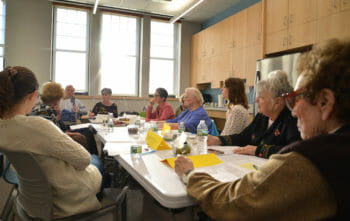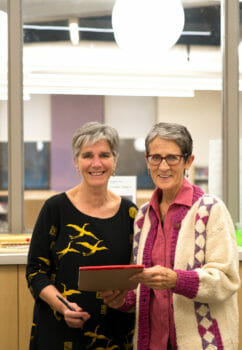Grass-Roots Movement Takes Off in Barrington
 By Susan E. Bouchard
By Susan E. Bouchard
What started out as a casual conversation about what an age-friendly community looks like has blossomed into an inspiring, grass-roots movement in Barrington, R.I.
In April of 2017, Age-Friendly RI and the University of Massachusetts presented the Healthy Aging Data report to a group gathered in Barrington.
Among the attendees were Barrington residents Laura Young, a career medical social worker, and her husband Frank Cummings, a retired physician. Young had recently become a member of the Providence Village and was very interested in the Village model of neighbors helping neighbors stay active in their communities as they grow older.
It seems all road were pointing in the age-friendly direction. Just a few weeks later, Young was speaking with Patricia Keefe, a retired funeral director and Barrington resident of more than 20 years. Keefe shared that she had been the caregiver for her own mother who lived to be 90, and she knew many of the challenges that came along with aging. Both Young and Keefe are members of the Senior Center Advisory Board and saw an opportunity to improve the health, well-being, and happiness of older residents in Barrington, a town where 16 percent of the population is 65 or older.

Laura Young (L) and Patricia Keefe (R) of Age Friendly Barrington
Both were inspired by the Age-Friendly and the Healthy Aging data information and decided they wanted to take the conversation to the next level. “We started thinking ‘Okay, where do we go from here?’ And at that point, we decided to start holding weekly meetings.” Young said.
Inviting anyone they could think of to attend, including other caregivers, community leaders, religious and civic groups as well as any interested residents, they sought their input on issues.
Before long their core group had grown to more than a dozen people. The new town manager invited the group to attend quarterly Community Support Coalition meetings his office organized. This quickly helped them reach an even wider group of people.
“We are contacting all of the places in town that we hope will give some input,” Young continued. Through these word-of-mouth outreach efforts and with the help of local high school student intern Sophia Mysak, the group has put together a resource book of more than 60 entries. The book is a compilation of various local and statewide resources that many in the community may not realize are already in place. In the near future, print copies will be available at Town Hall, the library and senior center and they are also planning to make an online version available on the town’s website.
Although Young and Keefe both have extensive experience with aging issues, they knew they didn’t have all the answers. And what they wanted to find out was what did Barrington residents really want. Drawing inspiration from the concept of neighbors helping neighbors, they decided to find out directly what concerns people had. They are currently in the information gathering phase. They developed a brief questionnaire and hosted seven focus groups with 47 participants. They also created a survey that is currently available on the town’s website. They are encouraging as many people as possible to take a few minutes to participate. So far they have had nearly 100 people fill out the survey.
“We have to find out what the town wants and who is going to be behind it,” Keefe said. The results, they believe, will provide valuable insight, benefiting generations to come.
“Our early survey responses are indicating a high interest in a volunteer network,” Young said, referring to the practice of reaching out to help their neighbors. “It seems so respectful to have seniors helping each other.”
They also found that although most of the seniors who they interact with at the senior center aren’t yet in need of the services, the idea is well-received. “Not everyone needs the services, not everyone has difficulties.” Young continued. “But,” Keefe chimed in, “there may come a time when they do. But they always think it’s a great idea.”
“One thing I find is the value of building the relationships and making the connections now before you need them. So that when you need help you already have established relationships. Because you can feel vulnerable at the time that you need help.” Young said.
“I think we have accomplished a lot,” Keefe said, “I think if we follow up on all the outreach we have planned, there will be much more visibility.” She continued, “then people might be ready to receive our results.” The group is planning to analyze the data in early 2019. When completed they will conduct a forum to publicize the findings and make recommendations to the town. “Our end result is a proposal that we will give back to the community,” Young said.
